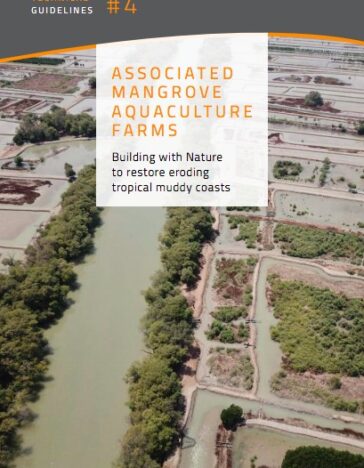
Technical Guidelines ‘Associated Mangrove Aquaculture Farms’
-
Aquaculture, fisheries and coastal agriculture
-
Coastal resilience
-
Coastal wetland conservation
-
Integrated delta management
This technical guideline discusses Associated Mangrove Aquaculture systems, in which part of an aquaculture pond is given up to make space for riverine mangroves. This approach enables the restoration of mangrove greenbelts in the estuary along inland waterways and the protection of adjoining fishponds.
In Indonesia this approach was implemented at district scale in the Building with Nature Indonesia project in Demak, Central Java to create a mangrove-based economy that integrates revitalisation of aquaculture productivity with mangrove restoration.
Mangrove greenbelts along rivers and creeks perform ecosystem functions, enhance biodiversity and increase economic opportunities for the local population. A mangrove greenbelt dampens waves and builds up sediment. They protect traditional earthen seawalls along rivers and ponds, and reduce their maintenance cost, while also enhancing fisheries and water quality. As such, Associated Mangrove Aquaculture systems offers a more sustainable alternative to silvo-fishery systems, of which several types are practised in Indonesia, but none that contribute to coastal protection, and some that may have negative effects on aquaculture.
The creation of sustainable mangrove aquaculture landscapes, and therefore the practices applied in Demak, are of global relevance given the severe decline in mangrove forests worldwide.
SUGGESTED REFERENCE
Bosma, R.H, Debrot, D., Rejeki, S., Tonneijck, F., Yuniati, A., W. & Sihombing, W. (2020). Associated Mangrove Aquaculture Farms; Building with Nature to restore eroding tropical muddy coasts. Ecoshape technical report, Dordrecht, The Netherlands.
TECHNICAL GUIDELINES SERIES
This guideline is part 4 of a series of Technical Guidelines on technical and socio-economic Building with Nature measures that, in combination, help to restored eroding tropical mud coasts. They bring together experiences and lessons learned from the Building with Nature Indonesia programme which restores eroding tropical muddy coasts. These guidelines are based on insights and lessons learned during the implementation of a district scale pilot in Central Java as part of the Building with Nature Indonesia program. By sharing our lessons learned in these practical guidelines, we aim to enable replication by government agencies, the water and aquaculture sector and NGOs.
Available Guidelines:
#1 Building With Nature Approach
#2 Systems Understanding
#3 Permeable Structures
#4 Associated Mangrove Aquaculture Farms
#5 Sustainable Aquaculture Through Coastal Field Schools
More information about Building with Nature Indonesia: www.indonesia.buildingwithnature.nl

